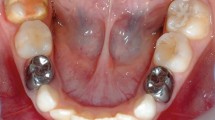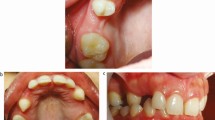Abstract
This paper examines the various contemporary clinical interfaces between paediatric dentistry and restorative dentistry for patients with both acquired and congenital abnormalities presenting to primary and secondary care. Dental trauma of the child or adolescent has long-standing implications on future oral health due to conditions such as ankylosis, pulp necrosis, coronal tissue loss or tooth loss, all of which provide significant challenges into adulthood. Similarly, congenital conditions, such as hypodontia and structural deficiencies or malformations, such as amelogenesis and dentinogenesis imperfecta, result in the need for collaborative, multi-speciality decision-making from a young age, creating a pathway for longitudinal multi-disciplinary team treatment planning.
Key points
-
Highlights contemporary clinical challenges for both paediatric dentistry and restorative dentistry specialties.
-
Stresses the need for foresight in the treatment planning and management of the child and adolescent.
-
Features conditions where optimal management in the adolescent has positive repercussions for the adult dentition.
This is a preview of subscription content, access via your institution
Access options
Subscribe to this journal
Receive 24 print issues and online access
$259.00 per year
only $10.79 per issue
Buy this article
- Purchase on Springer Link
- Instant access to full article PDF
Prices may be subject to local taxes which are calculated during checkout

















Similar content being viewed by others
References
Agarwal N, Kumar D, Anand A, Bahetwar S K. Dental implants in children: A multidisciplinary perspective for long-term success. Natl J Maxillofac Surg 2016;7: 122-126.
Alani A, Kelleher M. Restorative complications of orthodontic treatment. Br Dent J 2016; 221: 389-400.
Morgan E, Fox K, Jarad F, Albadri S. An investigation of transitional care pathways for young people following traumatic dental injuries. Br Dent J 2021; DOI: 10.1038/s41415-021-3471-4.
Borrelli B, Tooley E M, Scott-Sheldon L A. Motivational Interviewing for Parent-Child Health Interventions: A Systematic Review and Meta-Analysis. Paediatr Dent 2015; 37: 254-265.
Chan A, Antoun J S, Morgaine K C, Farella M. Accounts of bullying on Twitter in relation to dentofacial features and orthodontic treatment. J Oral Rehabil 2017; 44: 244-250.
Alani A, Kelleher M, Hemmings K et al. Balancing the risks and benefits associated with cosmetic dentistry - a joint statement by UK specialist dental societies. Br Dent J 2015; 218: 543-548.
Grey E B, Harcourt D, O'Sullivan D, Buchanan H, Kilpatrick N M. A qualitative study of patients' motivations and expectations for dental implants. Br Dent J 2013; DOI: 10.1038/sj.bdj.2012.1178.
NHS Digital. Child Dental Health Survey 2013. 2015. Available at https://files.digital.nhs.uk/publicationimport/pub17xxx/pub17137/cdhs2013-report2-dental-disease.pdf (accessed August 2022).
Arraj G P, Rossi-Fedele G, Doğramacı E J. The association of overjet size and traumatic dental injuries - A systematic review and meta-analysis. Dent Traumatol 2019;35: 217-232.
Marcenes W, Murray S. Social deprivation and traumatic dental injuries among 14-year-old schoolchildren in Newham, London. Dent Traumatol 2001;17: 17-21.
Agel M, Marcenes W, Stansfeld S, Bernabé E. School bullying and traumatic dental injuries in East London adolescents. Br Dent J 2014; DOI: 10.1038/sj.bdj.2014.1123.
Malmgren B. Ridge preservation/decoronation. J Endod 2013; DOI: 10.1016/j.joen.2012.11.056.
Demarco F F, Collares K, Coelho-de-Souza F H et al. Anterior composite restorations: A systematic review on long-term survival and reasons for failure. Dent Mater 2015; 31: 1214-1224.
Bimstein E, Rotstein I. Cvek pulpotomy - revisited. Dent Traumatol 2016;32: 438-442.
Malmgren B. Decoronation: how, why, and when. J Calif Dent Assoc 2000; 28: 846-854.
Malmgren B. Ridge preservation/decoronation. Paediatr Dent 2013; 35: 164-169.
Malmgren B, Malmgren O, Andreasen J O. Alveolar bone development after decoronation of ankylosed teeth. Endod Topics 2008; 14: 35-40.
Phillips J M, McCann C T, Welbury R. Endodontic Management of Traumatised Permanent Anterior Teeth. Prim Dent J 2020; 9: 37-44.
Marciano M A, Duarte M A, H, Camilleri J. Dental discoloration caused by bismuth oxide in MTA in the presence of sodium hypochlorite. Clin Oral Investig 2015; 19: 2201-2209.
Felman D, Parashos P. Coronal tooth discoloration and white mineral trioxide aggregate. J Endod 2013; 39: 484-487.
Cobourne M T. Familial human hypodontia - is it all in the genes? Br Dent J 2007; 203: 203-208.
Khalaf K, Miskelly J, Voge E, Macfarlane T V. Prevalence of hypodontia and associated factors: a systematic review and meta-analysis. J Orthod 2014; 41: 299-316.
Saltnes S S, Jensen J L, Sæves R, Nordgarden H, Geirdal A. Associations between ectodermal dysplasia, psychological distress and quality of life in a group of adults with oligodontia. Acta Odontol Scand 2017; 75: 564-572.
Al-Ani A H, Antoun J S, Thomson W M, Merriman T R, Farella M. Hypodontia: An Update on Its Etiology, Classification, and Clinical Management. Biomed Res Int 2017; DOI: 10.1155/2017/9378325.
Cameron J, Sampson W J. Hypodontia of the permanent dentition. Case reports. Aust Dent J 1996;41: 1-5.
Gill D, Barker C. The multidisciplinary management of hypodontia: a team approach. Br Dent J 2015; 218: 143-149.
Crawford P J, Aldred M, Bloch-Zupan A. Amelogenesis imperfecta. Orphanet J Rare Dis 2007; 2: 17.
Andersson K, Malmgren B, Åström E, Dahllöf G. Dentinogenesis imperfecta type II in Swedish children and adolescents. Orphanet J Rare Dis 2018; 22: 145.
Lygidakis N A, Garot E, Somani C, Taylor G D, Rouas P, Wong F S L. Best clinical practice guidance for clinicians dealing with children presenting with molar-incisor-hypomineralisation (MIH): an updated European Academy of Paediatric Dentistry policy document. Eur Arch Paediatr Dent 2021; 23: 3-21.
Fulton A, Amlani M, Parekh S. Oral manifestations of vitamin D deficiency in children. Br Dent J 2020; 228: 515-518.
Alani A, Bishop K. Dens invaginatus. Part 1: classification, prevalence and aetiology. Int Endod J 2008;41: 1123-1136.
Bishop K, Alani A. Dens invaginatus. Part 2: clinical, radiographic features and management options. Int Endod J 2008; 41: 1137-1154.
Author information
Authors and Affiliations
Contributions
Both Mona Agel and Aws Alani discussed, planned and contributed to the final manuscript.
Corresponding author
Ethics declarations
The authors declare that there are no conflicts of interest
Rights and permissions
About this article
Cite this article
Agel, M., Alani, A. The paediatric dentistry-restorative dentistry interface. Br Dent J 233, 475–482 (2022). https://doi.org/10.1038/s41415-022-4983-2
Received:
Accepted:
Published:
Issue Date:
DOI: https://doi.org/10.1038/s41415-022-4983-2



